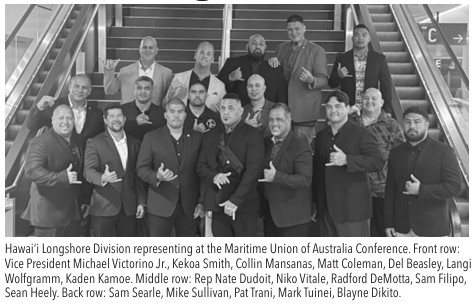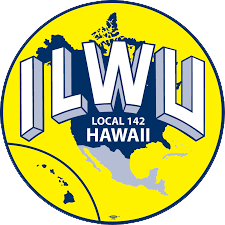
took to the mic at the conference to
provide a report on the status of La
haina fire recovery efforts. To date,
the MUA has donated approximately
$150,000.00 to Lahaina relief efforts
and, following Wolff’s report, donat
ed an additional $15,000.00.
Conference speakers highlighted the struggle to combat corporate and government anti-union efforts, industry projections around off-shore wind energy, and the Union’s work to secure national legislation similar to the U.S. Jones Act.
Conference speakers highlighted the struggle to combat corporate and government anti-union efforts, industry projections around off-shore wind energy, and the Union’s work to secure national legislation similar to the U.S. Jones Act.
dustry have participated in Steward
training put on by the Local. The
Division decided to create an indus
try-specific Steward training that
would give longshore members the
most targeted training possible, fo
cused on issues particular to the docks.
This round of training was part one
of the new three-part training created
and implemented by the HLD.
The training included industry-spe cific contract enforcement methods and a rich history lesson on the ILWU. Division Director Dustin Dawson pro vided an enlightening history of the creation of the Longshore Division.
The training included industry-spe cific contract enforcement methods and a rich history lesson on the ILWU. Division Director Dustin Dawson pro vided an enlightening history of the creation of the Longshore Division.
It’s been a busy month for the
Hawaiʻi Longshore Division.
Twenty members of the HLD trav
eled to Adelaide, Australia at the end
of February to attend the Maritime
Union of Australia’s Quadrennial
National Conference. The MUA
covers 16,000 maritime workers in
Australia across various industries,
including longshore.
as corporations make moves to take
our jobs.”
ILWU members were called to the stage as MUA leadership recalled the historic solidarity shown in 1998 when West Coast locals refused to unload an Australian ship that was loaded by scab labor. This solidarity forged deep and lasting bonds that endure today.
ILWU members were called to the stage as MUA leadership recalled the historic solidarity shown in 1998 when West Coast locals refused to unload an Australian ship that was loaded by scab labor. This solidarity forged deep and lasting bonds that endure today.
Steward training blitz
Upon their return, HLD Officers, Reps, and Business Agents entered a four-island Steward training blitz. The training began on March 6th at the Harry Kamoku Hall in Hilo, where 14 Stewards attended. This was followed by Maui on March 20th and Oʻahu on the 22nd, where upwards of 100 long shore workers were trained as Stewards.
Upon their return, HLD Officers, Reps, and Business Agents entered a four-island Steward training blitz. The training began on March 6th at the Harry Kamoku Hall in Hilo, where 14 Stewards attended. This was followed by Maui on March 20th and Oʻahu on the 22nd, where upwards of 100 long shore workers were trained as Stewards.
When asked about the emphasis
on history, Business Agent Tyrone
Tahara commented, “It’s imporatnt
for longshore workers today to un
derstand the sacrifices made by those
who came before them and to feel that
they are a apart of something larger
than themselves.”
Solidarity key focus
The ILWU along with maritime
and longshore unions from around
the world were invited to attend.
Local 142 Secretary-Treasurer Mike
Victorino Jr. was among those in at
tendance. “Global solidarity was the
focus. It’s important that we under
stand all of the issues in the industry.
It was clear at the conference that
everyone is committed to eachoth
er - ready to stand with eachother
Last Fall, solidarity between the
two Unions was in action at the War
on the Wharves charity boxing event,
hosted for the first time by the Hawaiʻi
Longshore Division at the ʻAlohilani
Hotel. Members of HLD and MUA
kept up the comraderie with sparring
and practice events during the MUA
conference.
HLD Division Rep Brandon Wolff
HLD Division Rep Brandon Wolff
as Stewards.
The final
training took
place on
Kauaʻi on
March 27th.
Since the Division was created in 2010, mem bersfrom the longshore in
Since the Division was created in 2010, mem bersfrom the longshore in

History of the ILWU Housing Program
FRED GALDONES IS PRESIDENT EMERITUS OF THE ILWU LOCAL 142. HE RETIRED IN 2010. HE WAS ONE OF 4 SPEAKERS
ON A PANEL ON HOUSING PRESENTED AT THE FULL TIME OFFICERS CONFERENCE. HIS TALK IS PRESENTED IN FULL
HERE AS A CLEAR AND INSIGHTFUL HISTORY OF THE ILWU’S WORK, OFTEN LEAD AT THE UNIT LEVEL, TO SECURE
AFFORDABLE HOUSING FOR MEMBERS.
“Building as a group or
collective bargaining, as
we know it, was the way to
negotiate the lowest cost, in
comparison to having each
person build on their own.”
Through collective bargaining, the
ILWU was successful in negotiating
employee housing at a reasonable cost.
In 1956-1958 the rent was:
For a single person renting single men’s quarters, based on the size of the room and the condition of the house, ranged from $3.00 to $19.00 per month.
For a family renting a home it ranged from $10.00 to $44.00 depending on the square footage of the home and its condition.
Water supplied by the sugar company was $1.00 per month.
The sugar industry was facing strong market competition from the European countries who were subsidized by their government, which could not be matched
In 1956-1958 the rent was:
For a single person renting single men’s quarters, based on the size of the room and the condition of the house, ranged from $3.00 to $19.00 per month.
For a family renting a home it ranged from $10.00 to $44.00 depending on the square footage of the home and its condition.
Water supplied by the sugar company was $1.00 per month.
The sugar industry was facing strong market competition from the European countries who were subsidized by their government, which could not be matched
by the US government, despite the sugar
industry and the ILWU lobbying heavily
to get favorable conditions in the Sugar
Act.
The cost of goods and mate rials continued to increase. There were increases in wage rates. Cost to do business increased. The sugar companies continued to look for ways to improve efficiency and reduce their losses.
In 1969-1972, sixteen years later, through collective bargaining, the ILWU was able to keep the rents the same. Recognizing the industry’s efforts to reduce their losses, especially in
The cost of goods and mate rials continued to increase. There were increases in wage rates. Cost to do business increased. The sugar companies continued to look for ways to improve efficiency and reduce their losses.
In 1969-1972, sixteen years later, through collective bargaining, the ILWU was able to keep the rents the same. Recognizing the industry’s efforts to reduce their losses, especially in
non-productive areas such as employee
housing, sometime after 1965, the union
leadership of Unit 6 of ILWU Local 142,
representing workers at Pepeekeo Sugar
Company, discussed having employees
owning their own homes. This was progressive think ing that was not readily accepted by the members of the Union be cause they were enjoying low-cost rental housing and would have to start paying mortgage at a higher rate. And there would be layoffs as the carpenter department would be eliminating jobs.
Be mindful that the ILWU, back in the mid-1950’s, agreed that in order to improve efficiency the sugar companies had to change their harvesting method
owning their own homes. This was progressive think ing that was not readily accepted by the members of the Union be cause they were enjoying low-cost rental housing and would have to start paying mortgage at a higher rate. And there would be layoffs as the carpenter department would be eliminating jobs.
Be mindful that the ILWU, back in the mid-1950’s, agreed that in order to improve efficiency the sugar companies had to change their harvesting method
from using flumes to harvest the cane
from the fields, which was labor intensive,
to using machinery to do the same job.
This meant a major job elimination of
the laborers in that department. However,
the ILWU was successful in negotiating
repatriation pay for those who returned
to their homeland.
This was a bold move on the Union’s part but progressive thinking on the part of the Union’s leadership. In this housing situation, again, it was a bold move, and looking at where the sugar industry is today, it was the correct thing to do.
The management at Pepeekeo Sugar Company agreed to set aside land area to develop a subdivision to build homes owned by the employees. In the process, the company would gradually close down plantation camps and in the long term, eliminate cost associated with employee housing.
—continued on page 8
This was a bold move on the Union’s part but progressive thinking on the part of the Union’s leadership. In this housing situation, again, it was a bold move, and looking at where the sugar industry is today, it was the correct thing to do.
The management at Pepeekeo Sugar Company agreed to set aside land area to develop a subdivision to build homes owned by the employees. In the process, the company would gradually close down plantation camps and in the long term, eliminate cost associated with employee housing.
—continued on page 8
